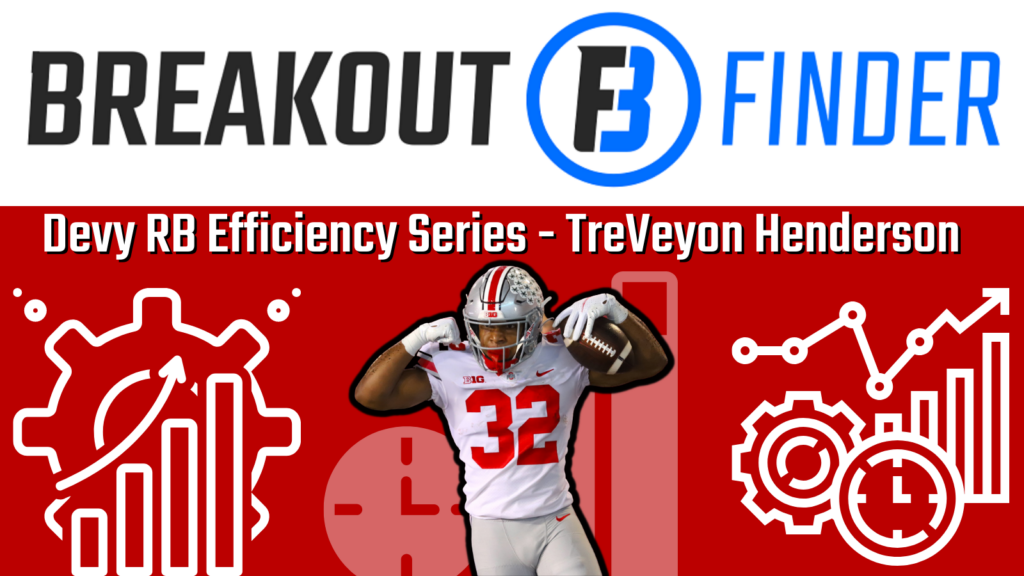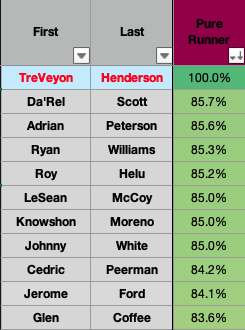This article is part of a series in which I evaluate current college running backs solely on their ability to run the ball. I previously did the same sort of analysis focused on the 2022 rookie running back class, and you can find those articles, as well as explanations of my methodology, here and here. Otherwise, feel free to skip to the player-focused analysis below.

Ohio State’s TreVeyon Henderson is just behind Texas’ Bijan Robinson as the consensus number-two back in devy formats. And for generally good reason. He was already listed at 5-10 and 215-pounds as a true freshman last season. And he had over 1,500 yards from scrimmage and 19 TDs on an 11-2, No. 6-ranked Buckeye team.
His 24.5-percent Dominator Rating is an 86th-percentile mark among first-year running backs. He’s one of eight runners to post a 20.0-percent-plus rating as a true freshmen in the Big Ten over the last 15 years. And he proved to be versatile, catching 27 passes and posting yards per target numbers in the 91st-percentile.
Let’s see how his efficiency on the ground stacks up to the rest of his box-checking profile.
The Metrics
With 183 rushing attempts in 13 games, TreVeyon Henderson handled an above-average carry load last season. Doing so while playing with backfield teammates who averaged a collective 3.56-star rating as high school recruits. That rating indicates 64th-percentile pedigree among teammates of backs who go on to be drafted since 2007.
Henderson gained 0.92 more yards per carry than those talented players did, a number in the 66th-percentile. He managed that output while seeing 0.28 more defenders in the box on his carries than those guys did, on average, a 93rd-percentile disadvantage. Considering those box counts, the average Henderson carry was worth 117.6-percent the output of the average carry from other Ohio State backs last season. That Box-Adjusted Efficiency Rating is in the 55th-percentile.
So on the aggregate, Henderson is producing more per carry relative to his backfield mates while seeing heavier fronts. A big part of that overall efficiency stems from Henderson’s standout performance in the open field. He extended 38.2-percent of his 10-yard chunk gains into breakaway runs of 20 yards or more; good for a Breakaway Conversion Rate in the 81st-percentile.
More Context
While he was awesome at navigating the secondary, TreVeyon Henderson wasn’t reaching it as frequently as other Ohio State runners. His Chunk Rate+, which measures his 10-yard run rate relative to that of his teammates, was -0.21-percent. That mark lands in the 37th-percentile, and it tracks with his poor performance in Relative Success Rate.
RSR measures how often a running back gains a requisite amount of yards given the down-and-distance situations he carries the ball in, relative to his teammates and weighted based on the box counts that he faces. It’s a measure of consistency in producing positive outcomes. Henderson’s RSR last season was an abysmal -6.2-percent, which lands in the 6th-percentile.
We sometimes see runners with impressive overall efficiency numbers because they can produce big plays despite not actually being good. Instinctive runners who consistently make good things happen at the point of attack. I won’t go that far in my evaluation given that I don’t have the film-watching expertise to make that claim. But something isn’t going well for him. Maybe he has poor vision. Or he’s impatient in waiting for blocks to develop. Or he’s a dancer in the backfield looking to hit a home run on every play. Whatever it is, he isn’t generating positive outcomes at an impressive rate. But he is producing efficiently due to his dynamism in the open field.
Rushing Efficiency Score and Comps
My process combines percentile scores in the above metrics (in addition to adjustments for overall team quality and strength of opponent) to generate composite scores that quantify a player’s overall rushing efficiency profile. In my process’ main composite, TreVeyon Henderson earns a 43.5 out of 100.
Using the same metrics that go into those rushing efficiency composites (in addition to physical measurables), I am also able to generate similarity scores between current and past prospects as a way of formulating comps. Using historical height and weight data for eventual NFL running backs, I project Henderson to be 5-10 and 211-pounds at his eventual Combine weigh-in. If he runs a 4.45 40-yard dash at that size, the following players will be his 10 closest comps from a “pure runner” perspective:

Some great players pop up in this comps list. He certainly has a level of dynamism that makes him reminiscent of some of recent history’s most explosive runners. Outside of the Adrian Peterson–LeSean McCoy–Knowshon Moreno trifecta, though, this list is populated mostly by unimpressive pro backs. That reflects the risk associated with the rawness shown in his efficiency profile.
Last Word
Overall, TreVeyon Henderson is a dynamic and versatile player. He posted impressive production on a great team immediately upon stepping foot on a college field. And he deserves to be taken among the top players in devy drafts. But the numbers reflect that he is not currently a refined or consistent runner of the football. He’s a young player who still has time to prove to be that, but projection is involved there. Draft accordingly.


